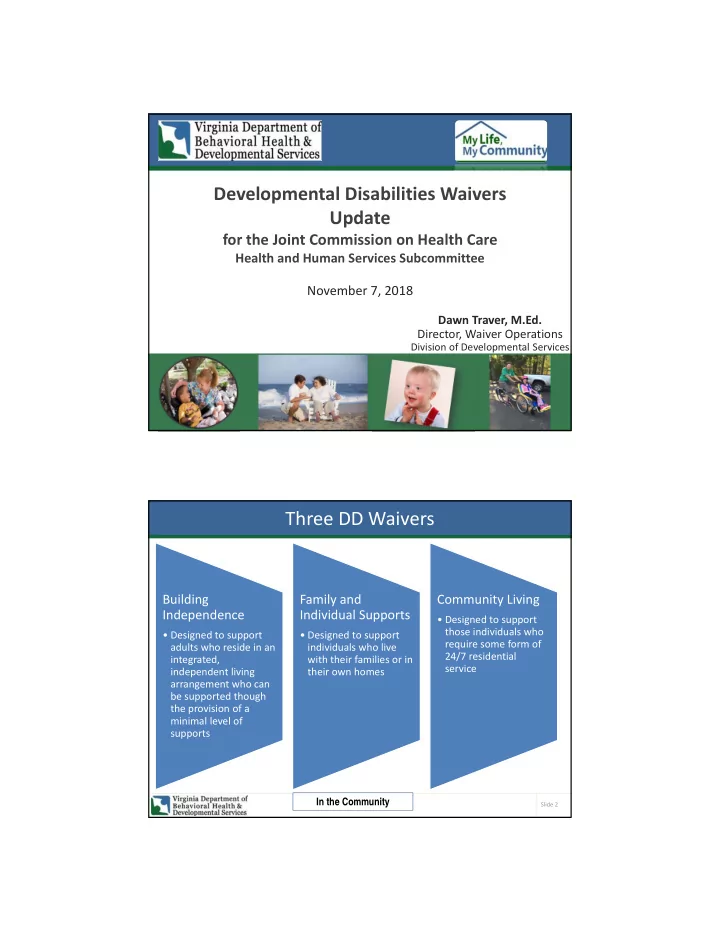

Developmental Disabilities Waivers Update for the Joint Commission on Health Care Health and Human Services Subcommittee November 7, 2018 Dawn Traver, M.Ed. Director, Waiver Operations Division of Developmental Services Three DD Waivers Building Family and Community Living Independence Individual Supports • Designed to support those individuals who • Designed to support • Designed to support require some form of adults who reside in an individuals who live 24/7 residential integrated, with their families or in service independent living their own homes arrangement who can be supported though the provision of a minimal level of supports In the Community Slide 2
Process for Obtaining a DD Waiver CSB Screening: DD Waiver slot Eligible individual diagnostic, available: most added to the DD functional, priority urgent people waiting list level reviewed by WSAC* Support Coordinator DBHDS assigns slot offers choice of to person(s) waiver services & determined most in providers need *Waiver Slot Assignment Committee Slide 3 Virginia’s DD Waivers Filled Slots as of 6/30/18 Family & Building Individual Independence Supports 2% 13% 325 1,867 11,752 Community Living 84% Total Filled DD Waiver Slots: 13,944 Slide 4
Newly Funded Waiver Slots Year New Slots for the Biennium CL waiver FIS waiver BI waiver TOTAL SFY 19 by SFY 414 129 community + 0 628 60 facility + 25 reserve FIS Waiver CL waiver BI waiver SFY 20 135 community + 807 40 1067 60 facility + 25 reserve 434 1221 40 1695 Biennium TOTAL by Waiver Slide 5 Virginia’s DD Waivers Total Slots as of 6/30/2020 Family & Building Individual Independence Supports 3% 20% 400 3,076 12,166 Community Living 77% Total DD Waivers: 15,642 Slide 6
Waiting List Update Priority I Priority II Priority III Projected to need Expected to need Expected to need services in a year services in 1-5 years services in five years or more 3,501 Individuals 5,656 Individuals 3,837 Individuals Total Waiting List = 12,994 Slide 7 Establish Groups of Individuals – Levels of Need 1 Mild Support Needs High 2 Moderate Support Needs 3 Mild/ Moderate Support Needs with Support Need Need Some Behavioral Support Need 4 Moderate to High Support Needs Suppor 5 Maximum Support Needs 6 Intensive Medical Support Needs Low 7 Intensive Behavioral Support Needs
How Much Support Do People Need? 40% 35% 7 37.2% 6 33.7% 30% 5 25% 20% 2 15% 4 10% 9.2% 1.7% 5% 7.1% 4.9% 6.2% 0% Level 1 Level 2 Level 3 Level 4 Level 5 Level 6 Level 7 Data as of 10/23/2018 Slide 9 How Have Living Situations Changed? 6,012 7,000 5,682 5,459 6,000 -5% 104% 12% 15% 146% 97% 53 5,000 8% 10% Number of 4,000 2,451 2,446 2,462 2,331 people 2,189 2,194 3,000 1,736 1,635 1,513 2,000 436 422 214 123 1,000 50 94 53 7 0 - Living Situation Arrows indicate change from Baseline Baseline 9.30.2016 9.30.2017 9.30.2018 Slide 10
Housing Update • 132 individuals transitioned to integrated, independent housing in FY 18 using Housing Choice Vouchers and State Rental Assistance Program (SRAP): – 64 have DD waiver services (47%) – 68 are on the DD waiver waitlist (53%); using community resources and natural supports to help them obtain and maintain housing • Expanding SRAP • Expansion of “Flexible Funding” Slide 11 Common Elements: Waivers and Managed Care • Provider Development • Holistic approach to health outcomes • Intended to decrease long-term, institutional care • Intended to decrease use of higher cost settings (e.g., congregate settings, Emergency Departments) “Managed care models don’t necessarily offer cost savings from reduced use of institutions because there is relatively low utilization of facility-based interventions and there is a waiting list of people looking for service. The budget management issue, whether in managed care or not, is really about providing a system that allows people with DD to live with families and friends rather than 24-hour staffed group homes.” ~ Nancy Thaler, past Director of NASDDDS and present Deputy Secretary for the Office of Developmental Programs in PA Slide 12
Jump-Start Slide 13 Next Steps: Supports Packages • A mix of residential and day services equating to an overall dollar amount range based on an individual’s living situation and level of needed supports • Types of living situations: Residential - Adults Living with Family - Children Residential - Children Living Independently - Adults Living with Family -Adults Building Independence Virginia’s approach: soft touch management tool for • case managers to have critical conversations Slide 14
Recommend
More recommend